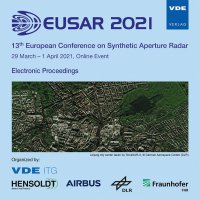Bistatic Science Phase Observations with a Large Perpendicular Baseline
Konferenz: EUSAR 2021 - 13th European Conference on Synthetic Aperture Radar
29.03.2021 - 01.04.2021 in online
Tagungsband: EUSAR 2021
Seiten: 3Sprache: EnglischTyp: PDF
Autoren:
Hong, Sang-Hoon (Department of Geological Sciences, Pusan National University, Pusan, Korea)
Wdowinski, Shimon (Department of Earth & Environment, Florida International University, FL, USA.)
Kim, Sang-Wan (Department of Energy & Mineral Resources Engineering, Sejong University, Seoul, Korea)
Inhalt:
High spatial resolution maps of relative water level changes in wetlands environment have been successfully generated using spaceborne interferometric synthetic aperture radar (InSAR) techniques. However, the wetland InSAR application has limited hydrological monitoring application, because it estimates water level changes not absolute water levels, which are used by hydrologists. TanDEM-X bistatic observations provide simultaneous phase measurements of water surfaces with a two-satellite constellation without temporal decorrelation. In this study, the TanDEM-X bistatic science phase observations with very large baseline (> 1.3 km) geometric configuration were evaluated to extract absolute water levels of the Everglades wetland in south Florida, U.S.A. Thanks to the large perpendicular baseline, spatial variation of water level surfaces with extremely low slope were estimated. We processed two datasets of TanDEM-X bistatic observations acquired on August 26 and 31, 2015. The perpendicular baselines are 1.43 km and 1.36 km and the ambiguity heights were calculated as 3.61 m and 3.90 m in each interferometric pair. The estimated absolute water level maps with 3.6 m and 7.4 m pixel spacing in range and azimuth directions (multilook factor of 4), respectively, show vast detailed variation of the water surfaces for each acquisition date. Hourly water level measurements obtained by stage stations, which are provided by the Everglades Depth Estimation Network (EDEN), were used for verifying the estimated absolute water levels. Some of stage stations, which are located in low interferometric coherence areas, such as dense vegetated and tree areas, were considered as outliers and were excluded from the comparison. The verification results show very good agreements (code of determination > 0.95) between the TanDEM-X derived absolute water levels and the stage station measurements. The root mean square error (RMSE) between the TanDEM-X results and stage records for the two datasets were 0.77 m and 0.66 m. Although, TanDEM-X bistatic observations have no temporal baseline, there are severe volume decorrelations over various tree types due to the very large perpendicular baseline. The TanDEM-L mission with longer wavelength of radar signal will enable us to generate more coherent interferometric phase observations over wetlands and, consequently, generate improved absolute water level maps.


